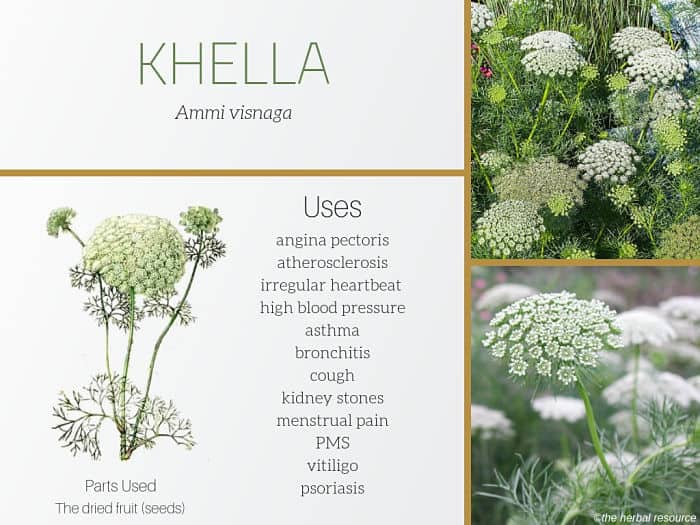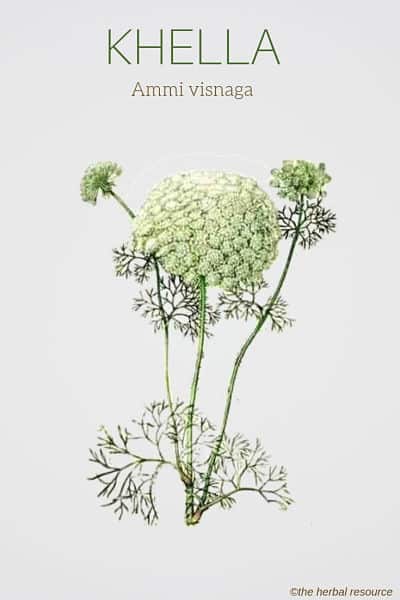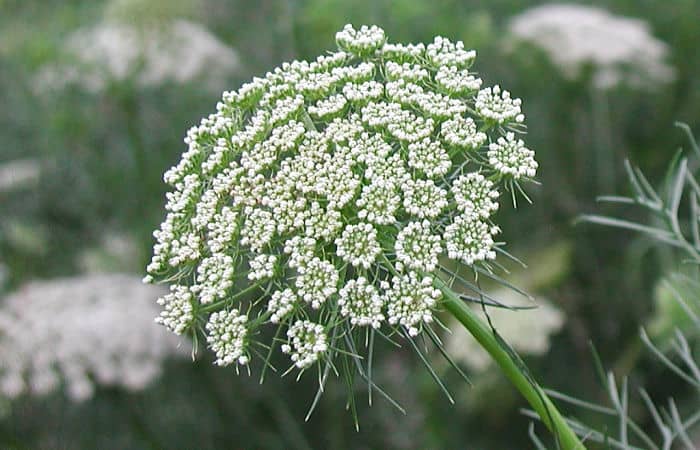Botanical Name of Khella: Ammi visnaga.
The genus name “Ammi” derives from the Greek term “ammos” meaning “sand” and refers to the plant’s habitat.
Khella is a member of the celery, carrot or parsley family (Apiaceae) and it has been used as a medicinal herb since ancient times for a variety of ailments.
It is known that the ancient Egyptians cultivated the plant and used it mainly for conditions related to the urinary trace system, a practice still in use today.
During the middle ages, it was not uncommon to use the herb as a diuretic.
The dried umbels of khella are often found in markets in the Middle and the Far East, where the flower stalks are used as toothpicks, a use which is reflected in the plant’s other common name “toothpick plant.”
What is Khella Used For?
Most of the therapeutic uses of khella are based on tradition and herbal folk medicinal applications.
In recent years scientific studies done on the herb have been mainly focused on two of its substances khellin and visnagin and their uses related to heart and respiratory conditions.
Khella should not be confused with bishop’s weed (Ammi majus).
The two plants contain some of the same active substances and share some medicinal properties. However, khella is more commonly used for heart and lung conditions, and bishop’s weed is mainly used for skin conditions.
People have used khella, e.g., for the following ailments and conditions:
- angina pectoris
- atherosclerosis
- irregular heartbeat (arrhythmia)
- high cholesterol
- high blood pressure
- asthma
- bronchitis
- cough
- whooping cough
- kidney stones
- menstrual pain
- PMS
- menstrual problems
- vitiligo
- psoriasis
Khella Uses for Asthma and Other Respiratory Conditions
Khella is regarded as a potent vasodilator which soothes muscle spasms of the bronchial airways.
It has traditionally been used to treat ailments associated with the respiratory system such as asthma, bronchitis, emphysema and whooping cough.
Studies done on the herb found that it did have an antispasmodic effect on the bronchioles and heart arteries, an effect mostly due to the substance khellin, which makes the herb helpful as a remedy for asthma and other repertory ailments. 1
The herb has a cumulative effect and is not regarded to be especially helpful during acute asthma attacks, but rather in preventing new attacks.
May be Beneficial for Angina and Other Heart Conditions
Visnagin is another substance that is isolated from khella, and, like khellin, it has been shown to have a relaxing effect on the coronary artery only 5-10 times stronger.
Visnagin has been regarded to be useful in the treatment of mild angina pectoris (sudden chest pain due to lack of oxygen to the heart muscle) and arteriosclerosis.
It increases blood flow (vasodilates the coronary arteries) to the heart muscle (myocardium) and makes metabolism more efficient. It has shown no hypotensive effect nor does it seem to increase the heart rate. 2
Khella does not have an immediate effect and must be used over a specified period before noticing any improvement.
Visnagin is therefore not useful to treat angina attacks but more as a preventative measure, i.e., between seizures. 3
Visnagin preparations have also been used as a follow-up treatment after a heart attack.
Other Uses
The herb has been used traditionally for premenstrual syndrome (PMS) and menstrual cramps.
It is also used to treat ailments associated with spasms and constriction of the gallbladder and bile duct and to ease the passing of kidney stones.
Several studies have been done on khella as a natural treatment for vitiligo, a skin condition in which the pigment cells (melanocytes), are destroyed causing progressive white pattern in the skin.
The results of these studies have been conflicting, and further research is needed to confirm the efficiency of khella as a treatment for vitiligo fully. 4
Khella has been used traditionally for psoriasis, and preliminary evidence seems to support this application, but additional studies are warranted to fully confirm if the herb is an effective therapy for psoriasis. 5
Active Ingredients and Substances
The most important active substances in the khella fruits are believed to be the furanocoumarins khellin, visnagin, khellol, and khellol glucoside and the pyranocoumarins visnadine, and samidin.
Furthermore, the herb contains flavonoids (including quercetin and isorhamnetin), plant sterols and a minimal amount (0.2%) of essential oil.
Plant Parts Used
The fruits (seeds) of khella are used in herbal medicine.
The fruits are collected in summer before they fully mature and dried for later use.
The seeds are used in tea, tincture or capsules, and standardized extracts of the seeds are used in medicine.
Therapeutic Dosage and Administration
Today, khella is mainly used in herbal mixtures that also contain other herbs, usually hawthorn (Crataegus monogyna) and lily of the valley (Convallaria majalis) for heart conditions such as angina pectoris, and in combination with other substances (often synthetic) for asthma and bronchitis.
Many of these ready to use preparations do not contain whole plant extracts, but isolated substances from khella, like khellin.
Khella can be used as tea even though it is not common.
As a tea: Add 0.5 g of the fruits to a cup of boiling water and allow to draw for 25 minutes.
The typical dosage of the tea is 3 to 4 cups daily.
As a tincture: 10-60 drops daily.
Preparations that are standardized to contain a certain amount of active substances in the fruits (khellin and visnagin) are used in various commercial medications.
For all commercial products containing khella or its active substances, the manufacturer’s instruction should be followed.
Side Effects and Interactions of Khella
Any herbal preparations containing khella or its active constituents should only be used under the guidance of a professional healthcare provider.
Pregnant women and breastfeeding women should not use the herb in any form.
Prolonged use or high does of khella can cause side effects like nausea, dizziness, loss of appetite, headache, and sleep disorders.
The herb might make some liver disease worse so people with any liver conditions should not use khella
The fruits contain furanocoumarins which may cause phototoxicity (increased sensitivity to sunlight).
The herb can also cause allergic skin reactions by skin contact.
Other Common Names
- Visnaga
- Toothpick plant
- Toothpick ammi
- Bishop’s flower
- Lesser bishop’s weed
- Visnaga
- Tandstikkerurt (Danish)
- Khellakraut (German)
- Bisnaga (Spanish)
- Sirosudenporkkana (Finnish)
- Herbe aux cure-dents (French)
- Tandpetarsilja (Swedish)
Habitat
Khella is native to North Africa and the Eastern Mediterranean countries. It is an introduced species in North and South America, and in Australia where it has become naturalized in many areas.
Commercial cultivation of the plant takes place mainly in Egypt, Morocco, and Tunis, but also in southern United States, Mexico, Chile, Argentina, and the former Soviet Union.
Description
Khella is an aromatic, annual or biennial that grows about 80 to 129 cm in height. The root is long pile-shaped taproot, and the stem is erect and highly branched at the top
The leaves are gray-green and have triangular or oval shape and divided into numerous small linear to lance-shaped segments resembling the leaves of carrot and fennel.
The white flower form a compound umbel similar to many other species belonging to Apiaceae family. Flowering usually takes place from Jul to September.
The egg-shaped fruits are about 3 mm long consisting of two mericarps. The small fruits contain tiny gray seeds.
Supporting References
Bown, Deni: The Royal Horticultural Society New Encyclopedia of Herbs & Their Uses. London, Dorling Kindersley 2002.
Brinker, Francis: Herbal Contraindications & Drug Interactions plus Herbal Adjuncts with Medicine. Fourth Edition. Sandy, Oregon, Eclectic Medical Publication 2010.
Buhner, Stephen Harrod: Lealing Lyme. Natural Prevention and Treatment of Lyme Borreliosis and Its Coinfections. Randolph, Vermont, Raven Press 2005.
Gruenwald, Joerg, et al.: PDR for Herbal Medicines. Fourth Edition. Montvale, New Jersey, Thomson Healthcare Inc. 2007.
Hashim, Saima, Asad Jan, Khan Bahadar Marwat and Muhammad Azim Khan: PHYTOCHEMISTRY AND MEDICINAL PROPERTIES OF AMMI VISNAGA (APIACAE), Department of Weed Science, The University of Agriculture Peshawar, Pak. J. Bot., 46(3): 861-867, 2014.
Pullaiah, T.: Encyclopedia of World Medicinal Plants. Vol I-V. New Dehli (India), Regency Publications 2006.
Skenderi, Gazmend: Herbal Vade Mecum. 800 Herbs, Spices, Essential Oils, Lipids Etc. Constituents, Properties, Uses, and Caution. Rutherford, New Jersey, Herbacy Press 2003.
van Wyk, Ben-Erik & Michael Wink: Medicinal Plants of the World. Portland, Oregon, Timber Press 2004.
Williamson, Elisabeth M.: Potter’s Herbal Cyclopaedia. Essex, Saffron Walden 2003.
Woolven, Linda & Ted Snider: Healthy Herbs. Your Everyday Guide to Medicinal Herbs and Their Use. Ontario, Fitzhenry & Whiteside 2006.
Thordur Sturluson
Latest posts by Thordur Sturluson (see all)
- What is the Difference Between Hemp and Marijuana? - June 3, 2019



Leave a Reply